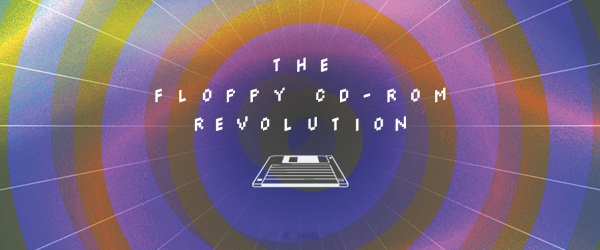Welcome to the Future!

In the framework of Welcome to the Future, iMAL asked several key actors in the cd-rom field to look back those booming years, and share their experience as publishers (Bob Stein, Pierre Lavoie, Étienne Mineur), artists (Antoine Schmitt, Suzanne Treister) or theorists (Geert Lovink).
Antoine Schmitt
«The experimentations of the first cd-roms had opened a questioning on the active relationships between humans and their environment in general»
Visual artist Antoine Schmitt uses computer software as his artistic material, at the heart of creations characterised by a minimalistic aesthetic. Originally computer engineer in the fields of man-machine relationship and artificial intelligence, he contributed to the creation of numerous cd-rom, including industrial (geographical information systems), cultural or edutainment projects. He worked in particular as a freelance for Hyptique, on cd-rom like La Bande-Son, Ça Se Transforme, Au Cirque Avec Seurat et Carton de Birgé et Vitet. In 1997, he was a technical adviser for Chris Marker on his Immemory cd-rom. As a developer and author, he helped with the art cd-rom Just from from Cynthia in 1996, under the artistic direction of Alberto Sorbelli, for which he created a random oracles generation and a virtual character. With the musician and sound artist Vincent Epplay, he created Infininite CD for Unlimited Music, a generative music cd-rom published in 1999.
Bob Stein
«What I realised is that they put microprocessors into everything and that eventually, all these « producer driven » media of the XXth century will be transformed into "user-driven media", like books were.»
Bob Stein founded The Voyager Company in 1985, an early pioneer of electronic books and interactive CD-ROMs. For 13 years, he led the development of over 300 titles in 'The Criterion Collection', a series of definitive films on videodisc, and more than 75 CD ROM titles including the CD Companion to Beethoven's Ninth Symphony, 'Who Built America', or I Photograph to remember. Previous to Voyager, Stein worked with Alan Kay in the Research Group at Atari on a variety of electronic publishing projects. In 2004, Bob Stein founded the Institute for the Future of the Book (www.futureofthebook.org), with the goal of finding new models for publishing as it moved from the page to the screen, from the enclosed world of the individual reader to the networked one of the Internet.
Étienne Mineur
«Thinking in terms of pictures and animations was not so simple at the time. All disciplines had to comply with technical constraints that were unheard of and very hard to master»
At once teacher at ENSAD, the Superior School of Decorative Arts in Paris, at Ensci and visiting professor in media design at HEAD (High School of Art and Design), Étienne Mineur, graphic designer with a passion for interactivity is also the co-founder and artistic director of the Incandescence design studio in 2000, known for its innovative websites. In 2009, he was co-founder and director of creation of "éditions volumiques", a research laboratory on books, paper and their relationship with technologiy (interactive books, augmented reality books, tangible/digital hybrid games).
Geert Lovink
«Other information architectures are possible! There is nothing wrong with such cyber utopia»
Geert Lovink is a dutch media theorist, net critic and activist. He studied political science on the University of Amsterdam (MA) and holds a PhD at University of Melbourne. Former editor of the media art magazine Mediamatic (1989-94), he was appointed in 2004 as Research Professor at the Hogeschool van Amsterdam and Associate Professor at University of Amsterdam. He is the founding director of the Institute of Network Cultures, and the founder of Internet projects such as nettime and fibreculture.
Pierre Lavoie
«Nous nous sommes rapidement rendu compte que, plutôt que de livrer le propos éditorial en kit, il fallait prendre la parole»
Pierre Lavoie a été président et directeur de création du studio multimédias français Hyptique de 1994 à 2005. Hyptique a édité un grand nombre de cd-roms et en a réalisé plusieurs, principalement dans le domaine de la musique. Pierre Lavoie a fondé également l'association Numer en 2000, introduisant le terme de design interactif en France et organisant des conférences rassemblant des designers internationaux. Il a cédé Hyptique en 2011 et œuvre aujourd'hui comme consultant sur des projets de déploiement numérique auprès des acteurs de la culture.
Suzanne Treister
«it was an exciting glitch in time, a genuine attempt to bring together all media into one format»
Suzanne Treister was born in London in 1958. Trained as a painter, she uses various supports, including video, internet and interactive technologies, photography and drawing. Between 1997 and 1999, she wrote, designed and developed a unique cd-rom accompanied with a book: No Other Symptoms – Time Travelling with Rosalind Brodsky. After frequently going to arcades in the 80s, and creating imaginary games start screens on her Amiga in the early 90s, Suzanne Treister created an alter-ego, Rosalind Brodsky, a time traveller working for the Institute of Militronics and Advanced Time Inverventionality in the 21st Century. Brodsky investigated military research projects led by this imaginary institute, which led in 2006 to the HEXEN 2039 project, an investigation on the development of new "mind control" technologies, through diagrams, drawings and photographs.
Opening: donderdag 19 maart
18:30-22:00
Data:
20 maart - 26 april 2015
woe - zon, 13:00-18:00
Gratis toegang!
Groepsbezoeken:
02 410 30 93
info@imal.org
Locatie: iMAL
Koolmijnenkaai 30
1080 Brussel
Een archief : 1999-2010-2019
Deze pagina is een archief van de iMAL website zoals die tussen 2010 en 2019 bestond. Alle activiteiten en projecten die sinds het begin in 1999 door iMAL georganiseerd zijn zijn hier gearchiveerd.
Het meest recente nieuws en activiteiten kan je terug vinden op onze nieuwe website: imal.org
